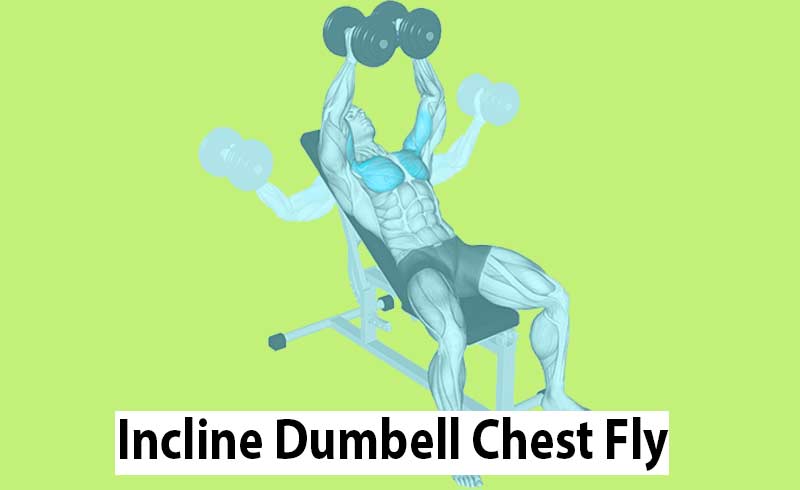Get ready to boost your upper chest strength and muscle with the incline dumbbell chest fly exercise.
This powerful exercise targets different angles of your chest and prioritizes your upper chest and shoulders.
A well-built upper chest not only enhances your physique but also aids in everyday tasks.
In this beginner’s guide, we will cover the following:
- What are Incline dumbbell Flyes
- Muscles worked during the exercise
- Step-by-step Execution Guide
- Optimal Sets and Repetitions
- Benefits of Incline Dumbbell Fly
- Variations for Diversified Training
- Alternatives for Exercise Variation
What Is Dumbbell Incline Fly Exercise?
The incline dumbbell fly, also known as the incline dumbbell bench fly, is an effective isolation exercise primarily targeting the upper portion of the pectoral muscles (chest muscles).
This exercise is particularly popular among individuals aiming to develop well-rounded and aesthetically good-looking chest muscles.
It is often seen as a great way to conclude a workout session.
After completing more comprehensive exercises that engage several muscles at once, like the bench and incline press, this exercise provides a concentrated effort for your upper chest muscles.
It helps in targeting and toning the chest area, providing a focused finish to your pec workout routine.
Muscles Targeted by Incline Dumbbell Fly: Inner Pectorals and Upper Chest
When executed the right way, incline dumbbell flyes provide targeted engagement to your inner pectoral muscles, as well as your upper chest.
While the primary target is to isolate and develop the chest muscles, this exercise also contributes to sculpting a more defined upper chest area.
Incline Dumbbell Flie Benefits
1. Better Upper Body Posture:
This exercise can improve how you stand and sit. it strengthens your chest and shoulder muscles, which can pull your shoulders back and down, making your posture more upright.
2. Balanced Muscle Development:
Incline dumbbell flyes target the upper part of your chest more than some other pectoral exercises. This helps you achieve balanced and fast chest muscle growth.
3. Enhanced Aesthetic Appeal:
Strengthening and shaping your chest muscles with incline dumbbell flyes can contribute to a more defined and attractive chest appearance.
4. Functional Strength:
This exercise mimic movement you might use in everyday activities, like pushing or lifting. This can enhance your overall strength for real-world tasks.
5. Engages Stabilizer Muscles:
Incline dumbbell flyes require you to stabilize your body and control the weights. This engages smaller, supporting muscles that help improve your overall stability and coordination.
6. Variation and Muscle Confusion:
Incorporating incline dumbbell flye into your routine adds variety, which can prevent boredom and keep your muscles from getting too used to the same exercises.
7. Improved Shoulder Movement:
Proper shoulder mobility is crucial for various activities in daily life and during workouts. Incline dumbbell flyes involve a controlled and full range of motion for your shoulder joints.
This helps keep your shoulder muscles flexible and adaptable.
Improved shoulder mobility not only prevents stiffness but also reduces the risk of injuries caused by limited movement.
8. Good Alternative to Bench Press:
Some individuals may find classic bench presses uncomfortable or even painful due to their body mechanics or joint sensitivities.
Dumbbell incline fly offer an effective alternative, they allow you to work your chest muscles without requiring the same degree of shoulder and elbow mobility as bench presses.
This variation lets you engage your chest muscles without compromising your comfort.
How To Do Incline Dumbbell Chest Fly
Here’s how you can do in 8 steps:
- Begin by finding an incline bench and adjusting it to an angle of roughly 30 degrees. This angle is important because it targets your upper chest while also engaging your shoulders to some extent.
- Next, pick the right pair of dumbbells for yourself, you should choose weights that match your strength level.
- Sit down on the incline bench and hold a dumbbell in each hand. Your palms should be facing each other. Position the dumbbells at the top of your thighs.
- Liee back on the bench while lifting the dumbbells up to shoulder level. Make sure your back, head, and buttocks are firmly placed on the bench while keeping a slight arch in your lower back.
- Take a deep breath and then push the dumbbells upward. Fully extend your arms without locking out your elbows. This is your starting point for the exercise.
- Breathe in as you slowly lower the dumbbells in a controlled manner. Allow your elbows to bend as the dumbbells move outward and downward.
- When the dumbbells reach chest level or just slightly below, exhale and press them back up to the starting position. You do this by contracting your chest muscles.
- Repeat the entire movement for the number of times you want to do. It’s important to focus on doing it correctly rather than rushing through.
Here are some additional tips to keep in mind:
- Incline Angle: An incline of about 30 degrees is ideal for targeting the upper chest. If you go steeper, you might involve more of your shoulder muscles.
- Grip: Don’t grip the dumbbells too tightly. Holding them with a controlled grip is better to avoid putting too much strain on your forearms and biceps.
- Avoid Dumbbell Contact: Keep a gap between the dumbbells at the top of each repetition. This way, your chest muscles stay engaged throughout.
- Elbow Position: Keep your elbows slightly bent throughout the movement. Also, avoid letting the dumbbells descend too far to prevent shoulder strain.
- Core Engagement: Tighten your core muscles and avoid arching your lower back too much. This helps you stay stable during the exercise.
- Choosing the Right Weight: Don’t go for dumbbells that are too heavy. Using weights that you can manage with proper form is more important than lifting really heavy.
- Slow and Controlled: Moving slowly and with control increases the time your muscles are under tension. This promotes better muscle growth and development.
The Importance of Proper Form:
We’ve all seen it at the gym, individuals attempting dumbbell fly with determination, but often struggling with improper form.
It’s time to shed light on this common issue and learn how to correct it for optimal results.
The Mistake: Bent Elbows and Shoulder Proximity:
You might notice folks performing dumbbell flys with their elbows bent, bringing the weights closer to their shoulder joint. However, this approach unintentionally makes the exercise easier.
The Right Way: Elbow Extension for Maximum Chest Activation:
To get the most out of incline dumbbell fly, here’s the key: start with your shoulder blades retracted and chest expanded.
Incline Dumbbell Fly Variations
1. Dumbbell Stability Ball Incline Flys
The stability ball incline fly offers a unique challenge by introducing instability into the exercise.
This variation forces you to focus more on utilizing stabilizing muscles within the shoulders and core to execute the movement in a controlled and efficient manner.
Research has delved into the effects of unstable surfaces and their impact on the dumbbell fly, considering both stable and unstable platforms as well as incline and flat variations.
How To Do Stability Ball Dumbbell Incline Chest Flye:
- Sit on an exercise ball while holding dumbbells in each hand.
- Roll down on the ball until your head and neck are on the ball, and your feet are planted on the floor ahead of you.
- Lift the dumbbells straight up above your chest, maintaining a strong squeeze throughout.
- Hold this position briefly, then lower the dumbbells back to the starting position.
- Repeat for the desired number of reps and sets.
2. Dumbbell Incline Fly Isometric Hold
This variation adds an isometric element to the incline fly, intensifying the engagement of stabilizer muscles while providing a deep stretch to the chest muscles.
During the isometric incline holds, you hold the dumbbells at the bottom position of the fly, creating a static contraction.
How To Do Dumbbell Incline Fly Isometric Hold:
- Lie on the incline bench and hold a dumbbell in each hand.
- Begin the fly motion by lowering the dumbbells toward the sides of your chest.
- Once you reach the bottom part of the movement, hold the position for up to 30 seconds.
I recommend starting with a lighter weight compared to what you’d use for the regular incline fly. - Maintain a controlled and stable hold throughout the isometric phase.
- Gradually increase the hold duration as you become more comfortable with the exercise.
3. Single-Arm Dumbbell Pec Fly
The one-arm dumbbell flys presents a unique challenge compared to the regular incline fly.
This variation requires enhanced engagement from your upper body and core muscles as they work to stabilize you during the unilateral movement.
Performing the single-arm fly allows you to concentrate on muscle contraction on one side of your body at a time.
This not only diversifies your training but also permits the identification of any muscle imbalances.
By discerning weaker areas, you can devise a strategy to restore symmetry and balance in your strength development.
How To Do Single-Arm Dumbbell Flye:
- Lie on the incline bench and hold a dumbbell in one hand.
- Extend the arm with the dumbbell upwards, keeping a slight bend in your elbow.
- Slowly lower the weight to the side while maintaining control and stability.
- Focus on contracting your biceps and chest muscles.
- Raise the dumbbell back to the starting position.
- Do the desired reps on one side before switching to the other hand.
4. Dumbbell Incline Twist Fly
This variation isolates the upper chest muscles even further and provides a unique contraction through the twisting motion of the dumbbells.
It also enhances the shoulder range of motion.
How To Do Dumbbell Incline Twist Fly Properly:
- Lie on an incline bench while holding a dumbbell in each hand with a neutral grip.
- Start with the weights above you at shoulder height.
- Slowly lower the dumbbells laterally while maintaining the elbow angle.
- When the dumbbells reach chest level, reverse the movement by squeezing your chest muscles together.
- As the dumbbells return to the starting position, twist the handles so that the bottoms of the dumbbells nearly touch.
- Untwist the handles to a neutral position to start the next repetition.
- Continue until the set is completed.
Dumbbell Incline Fly Alternative Exercises
The purpose of these alternatives is to provide different ways to work the same muscle groups and achieve similar benefits.
Criteria for Alternatives: Let’s start by outlining the criteria that a good alternative exercise should meet in order to effectively replace the “Dumbbell Incline Chest Fly”
These criteria are:
- Activating the same chest muscle groups as the incline dumbbell chest fly.
- Isolating the targeted muscle groups during the exercise.
- Providing a longer range of motion to effectively work the chest muscles.
1. Incline Dumbbell Press Exercise:
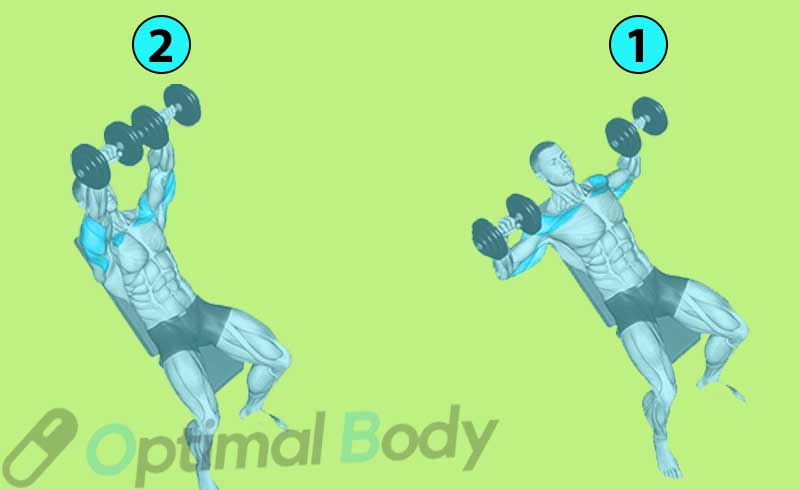
This exercise is considered the best replacement for the incline dumbbell chest fly when it comes to developing the middle and upper pectoral muscles.
Similar to the incline bench press, the incline dumbbell press primarily focuses on the upper part of the chest.
However, the use of dumbbells allows for a greater range of motion compared to using a barbell, making it potentially more effective.
It can also be done using cables. take your time to experiment with them so that you get the most out of the benefits.
2. Push-Up With Feet Elevated:
This chest fly alternative also known as the decline push up, is a bodyweight exercise that involves placing your feet on an elevated surface, such as a bench or a step, while performing push-ups.
This variation shifts more of the workload to the upper chest muscles and can provide a similar range of motion as the incline dumbbell chest fly.
3. Landmine Press:
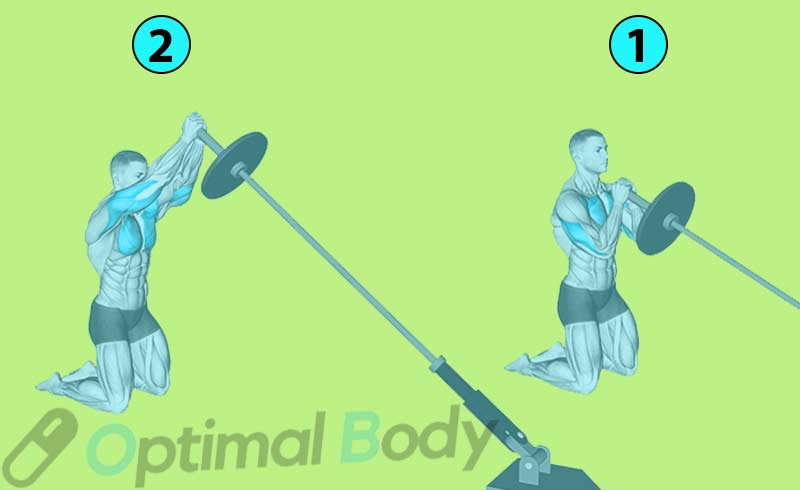
This alternative exercise utilizes a landmine attachment, which is a barbell anchored in a pivot point, allowing for rotational movement.
To perform the landmine press, hold one end of the barbell and press it upward at an angle.
Check more: exercises that are like landmine presses
4. Incline Cable Chest Fly:
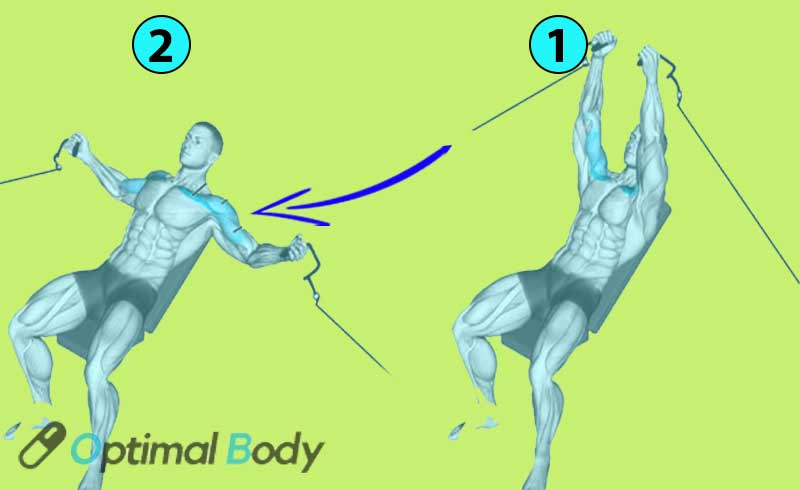
This workout is recommended for isolating the upper chest muscles.
Unlike using dumbbells, the use of cables in this exercise creates constant tension throughout the whole ROM (range of motion), which can contribute to building the fibers of the upper chest.
This exercise is particularly effective when a cable machine is available to you.
5. Standing Dumbbell Fly:
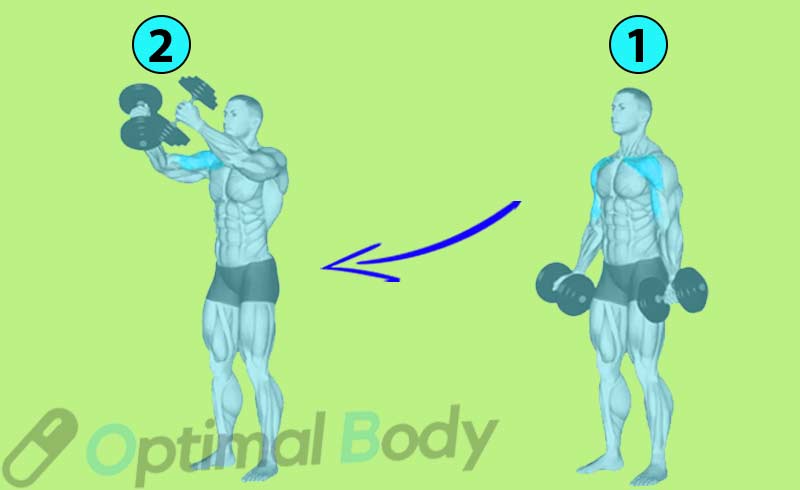
This variation of the traditional dumbbell chest fly focuses on both the chest and shoulder muscles in a unique way. It can help broaden and develop the chest area, especially the upper chest.
This exercise is highlighted as a convenient option for those looking for a home-based alternative to the incline dumbbell fly.
To Wrap Up:
Integrating incline dumbbell fly into your chest routine can truly revolutionize your gains.
As you progress in your fitness journey, mastering the incline dumbbell chest flyes becomes increasingly rewarding.
While you might not be lifting as heavy weights as you did previously, the gains you’ll experience in terms of chest development will be more than worth the adjustment.
References:
- Solari F, Burns B. Anatomy, Thorax, Pectoralis Major Major. [Updated 2023 Jul 24]. In: StatPearls [Internet]. Treasure Island (FL): StatPearls Publishing; 2023 Jan-. Available from: https://www.ncbi.nlm.nih.gov/books/NBK525991/
- Lauver JD, Cayot TE, Scheuermann BW. Influence of bench angle on upper extremity muscular activation during bench press exercise. Eur J Sport Sci. 2016;16(3):309-16. doi: 10.1080/17461391.2015.1022605. Epub 2015 Mar 23. PMID: 25799093.
- Lephart SM, Fu FH, eds. Proprioception and Neuromuscular Control in Joint Stability. Champaign, Ill: Human Kinetics; 2000.
- Reiser, Fernando & Lira, Jumes & Bonfim, Beatriz & Filho, Solival & Durante, Bruno & Cardoso, João & Miotto, Hamilton & Soares, Marcos & Bonuzzi, Giordano & Tavares, Lucas. (2017). Electromyography of Dumbbell Fly Exercise Using Different Planes and Labile Surfaces. Journal of Exercise Physiology Online. 20. 31.
- Alvar. (n.d.). Effects of different volume-equated resistance training loading strategies on muscular adaptations in well-trained men. Journal of Strength and Conditioning Research., 28(10), 1–2918. https://doi.org/info:doi/
- Bench Press Calculator - April 22, 2024
- Press to Handstand: Ultimate Step-by-Step Guide - April 22, 2024
- Cable Press (How To Do, Benefits, Targeted Muscles, Alternative) - April 22, 2024

